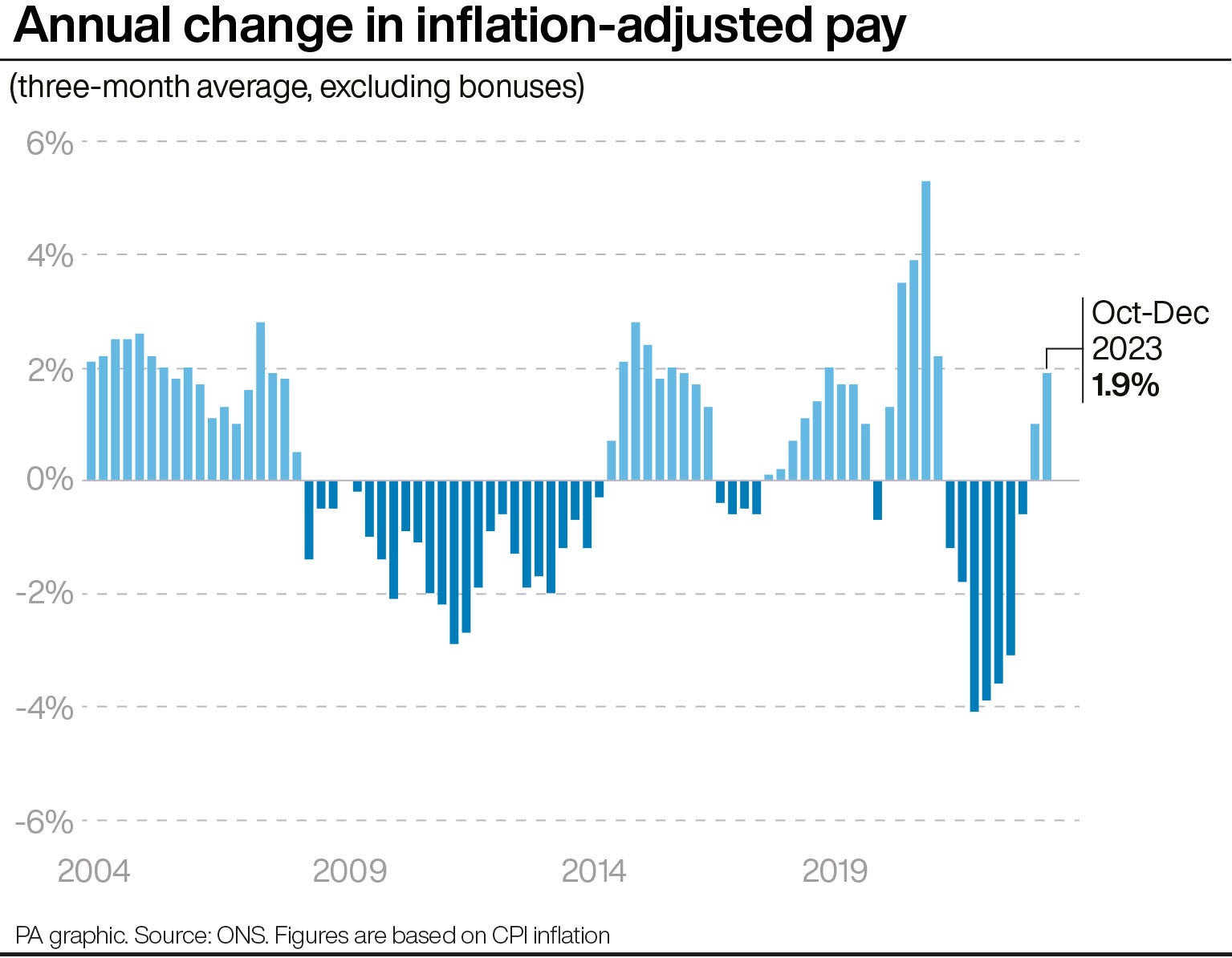UK likely to have slipped into recession, experts say
Economists are forecasting a 0.1% decline in GDP between October and December
Your support helps us to tell the story
This election is still a dead heat, according to most polls. In a fight with such wafer-thin margins, we need reporters on the ground talking to the people Trump and Harris are courting. Your support allows us to keep sending journalists to the story.
The Independent is trusted by 27 million Americans from across the entire political spectrum every month. Unlike many other quality news outlets, we choose not to lock you out of our reporting and analysis with paywalls. But quality journalism must still be paid for.
Help us keep bring these critical stories to light. Your support makes all the difference.
The UK is expected to have slipped into recession at the end of last year after a weak December for the country’s economy, official figures are set to show.
The Office for National Statistics (ONS) is predicted to reveal that the UK economy contracted for the second quarter in a row in the final three months of 2023.
Most economists are forecasting a 0.1% decline in gross domestic product (GDP) between October and December.
This would follow a 0.1% contraction in the previous three months, after a downward revision against the zero growth initially estimated.
A contraction in the fourth quarter would mean the UK tipped into a technical recession, as defined by two or more quarters in a row of falling GDP.
What is a recession?
There is no real definition
It is seen as a time when the economy is declining, but there is no globally standardised way of saying exactly how much decline and exactly how long the period has to be.
In the UK, the most generally accepted definition of a recession is two quarters in a row when gross domestic product (GDP) falls.
But that means even if GDP drops by 0.01% one quarter and 0.01% again the next we are technically in a recession.
That would be a very shallow recession and much less painful than if GDP shrunk by 3% one quarter and rose by 1% the next – which would not be a recession.
Other countries measure recessions in different ways, taking into account the size of the drop or other factors.
Experts have said that if confirmed, it would be a recession in the “mildest of senses” and is likely to be short-lived, with many preferring to describe the UK’s economy as having “stagnated”.
But a recession would deal a blow to Mr Sunak who has promised to grow the economy as one of his five priorities.
The fourth quarter figures will also reveal how the economy fared over 2023 as a whole, with expectations that it will have been weak.
ONS estimates suggest the economy did not grow at all between April and June before shrinking between July and September, which has left the UK at risk of recession in the final three months.
Ellie Henderson at Investec said: “Our base case is that the economy probably did tip into a recession, although this would be in the mildest of senses: a better description of the trend might be stagnation.”
Investec is pencilling in a 0.1% contraction in the fourth quarter, with weak retail data dragging on the all-important services sector and leading to a 0.3% fall in output in December.
Ms Henderson added: “In all, we expect that it was a tough end to the year for the UK economy, but 2024 is likely to have got off to a better start as household budgets look to have loosened a little.
“Indeed, the decline in inflation combined with still high wage growth will continue to drive real household disposable incomes higher, a key factor behind the expected recovery this year.
“There will also be the added lift to post-tax incomes from the 2p cut to employees’ National Insurance Contributions, effective from January 6 – and, in all likelihood, more to come in the March Budget.”
Bank of England governor Andrew Bailey has also signalled that a recession, if confirmed, would likely be brief, telling a Lords committee on Wednesday that the UK economy was beginning to pick up.

Mr Bailey told the House of Lords Economic Affairs Committee: “In our February Monetary Policy Report, it was in the balance – we didn’t have a recession in the forecast, but it is at best flat, in the view we took.
“It wouldn’t take much to tip it either way, frankly.
“Going forward, and I think this is in some ways more significant, we are now seeing some signs of the beginning of a pick-up in some of the surveys, for instance … we’ve got a modest pick-up this year which continues thereafter.”
Samuel Tombs at Pantheon Macroeconomics said that while he was also forecasting a 0.1% decline in the fourth quarter, the prospects were already brighter.
He added: “December’s GDP report … will create a negative first impression, but the reality is the economy is now on the up.
“Developments since our last forecast review at the start of January have left us more confident in our above-consensus forecast that quarter-to-quarter growth in GDP will pick up to an average rate of 0.3% this year.”
But a technical recession may further add to the case for an interest rate cut, with the Bank already indicating it is more a case of when, not if, a reduction will come.
Official data on Wednesday showing inflation defied expectations for a rise in January to unexpectedly hold firm at 4% was also seen as giving policymakers at the Bank more room to consider rate cuts, from the current level of 5.25%.
